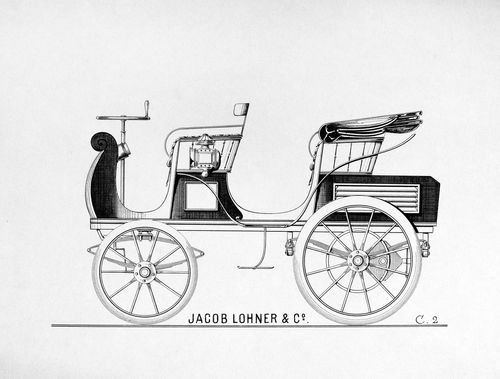Porsche’s True Roots…A 21-mph Electric Vehicle
MENTION THE WORD “Porsche” and what immediately comes to mind… Without a doubt you instantly think of a horseless carriage with electric drive, correct?
Well, OK, maybe the image of a well-engineered, high-performance sports car might pop up as well, but if you were to picture an ancient electric vehicle that greatly resembles a carriage without its team of trusty steeds, you definitely would be on target.
That’s because Ferdinand Porsche, the patriarch of those sleek street and track racers, first made a name for himself as a builder of electric cars more than a century ago.
Wasn’t Supposed to Be a “Car Guy”
Interestingly enough, if Ferdinand had been more of a strict believer in family traditions and followed a tradition-dictated path, he would have become a craftsman in the manner of his father, Anton, who was a master tinsmith. Instead, however, Ferdinand was more of a leading edge kind of guy, for the times at least, deciding that he wanted to enter the relatively new field of electrical engineering.


Even though he had no formal training, Porsche quickly rose from an apprentice position to a supervisory role with an engineering company in Vienna. It was in that capacity that he became acquainted with Ludwig Lohner, a Viennese carriage manufacturer who had come to believe that the luxury carriage business was about to give way to the building of gasoline- and electric-powered vehicles. Furthermore, Lohner felt that electric vehicles would do well in the marketplace because they were quiet and didn’t emit exhaust fumes.
And that’s how Ferdinand Porsche got his start in the automotive business.
The Egger-Lohner C.2 aka the P1
The first Lohner electric vehicle concept developed with some input from Porsche didn’t quite make the cut and was discarded in favor of one that was more in line with Porsche’s vision for the car. For instance, the first concept had the electric motor between the front wheels and steered the rear wheels. Porsche favored front wheel stub axle steering and placement of the motor at the rear of the carriage. (Hmmm, that last part sounds something like a 911, doesn’t it.)
The finished product, called the “Egger Lohner C.2 electric vehicle” rolled through Vienna for the first time on June 26, 1898. Although the vehicle was not listed as a Porsche, young Ferdinand engraved the code “P1” (P for Porsche, number 1) on all of the key components, thus taking credit for his work and giving the car its unofficial name.
Among Porsche’s inventions used on the car was his octagon electric motor which took its name from the eight-sided design of the housing. It weighed 287 pounds and had an output of 3 to 5 horsepower which translated into a top speed of about 21 mph and a range of about 50 miles. The vehicle was regulated via a 12-speed controller with six forward gears, two reverse gears and four braking gears. To enable this, Porsche coupled the commutators both consecutively and in parallel.
Testing It In a Race
To see how it would perform against competition and to gain some publicity, the P1 was entered into a 24-mile (40 kilometer) race in September 1899 at a motor vehicle exhibition in Berlin. It turned out to be quite a day for the vehicle and Porsche as he finished 18 minutes ahead of the next competitor while more than half of the participants failed to complete the run due to technical problems.
Still, the big win didn’t translate into market success as only four of the vehicles were built. But before Porsche went on to attain lasting success in the gas-powered world, he developed other electric vehicles including a sports car with four electric wheel-hub motors and a vehicle that combined his battery-powered wheel-hub motors with a gasoline engine. In other words, an all-wheel drive vehicle and a hybrid, and who said those were modern ideas?
A Barn Find for the Record Books
Meanwhile, the P1 was placed in a storage shed in 1902 where it sat until it recently was brought out by Porsche (the company, not Ferdinand) and put on display in the Porsche Museum in Stuttgart-Zuffenhausen.
Unfortunately, the car did not make it through the 1900s unscathed, as major components such as its body and seats were missing when the car was retrieved. Still, based on period illustrations, the company has fitted the early electric vehicle with translucent plastic pieces to provide an idea of what it looked like when it was traveling the German roadways at speeds reaching as high as 21 mph.
–Ted Kade
















